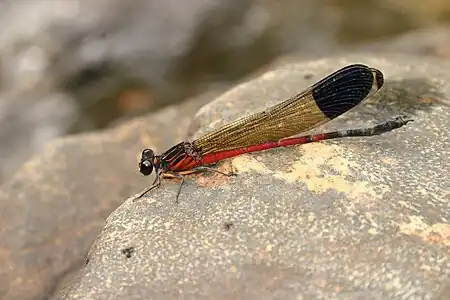Euphaea dispar
Euphaea dispar,[2][1] Nilgiri torrent dart,[3][4] is a species of damselfly in the family Euphaeidae.[1]
| Euphaea dispar | |
|---|---|
 | |
| Male | |
| Scientific classification | |
| Domain: | Eukaryota |
| Kingdom: | Animalia |
| Phylum: | Arthropoda |
| Class: | Insecta |
| Order: | Odonata |
| Suborder: | Zygoptera |
| Family: | Euphaeidae |
| Genus: | Euphaea |
| Species: | E. dispar |
| Binomial name | |
| Euphaea dispar Rambur, 1842 | |
This species is endemic to the Western Ghats, known to occur only in north of the Palghat Gap; Dakshina Kannada, Udupi and Kodagu to the Nilgiris.[5][1][6]
Description and habitat
It is a medium sized damselfly with black head and brown-capped pale grey eyes. Its thorax is black, marked with bright ochreous-red antehumeral and humeral stripes. Lateral sides of the thorax in the base is red. Its all legs are yellow at base and remaining segments are dark. Wings are narrower than Euphaea cardinalis. Fore-wings are transparent, black on the extreme apices. Hind-wings are transparent; but nearly one third of the wings from the apices are broadly black. Abdomen is bright red up to the segment 6; apical third of segment 6 to the end segment are black. Anal appendages are black. The males of this species can be easily distinguished from other Euphaea species by the small black tips on apices of fore-wings.[5]
Female is short and robust; the ochreous-red of male is replaced with yellow colors. All wings are transparent, enfumed with black in adults. Abdomen is black with yellow lateral stripes up to segment 6. The yellow lateral stripes continued to segment 7. Segment 8 has a narrow and 9 has a broad yellow apical annule, covering dorsal half.[5]
They breed in streams flowing through evergreen forests. Usually the males are found perched on the twigs hanging above the water or on the rocks.[5][7][8][3][4]
References
- Kakkasery, F. (2011). "Euphaea dispar". IUCN Red List of Threatened Species. 2011: e.T175155A7114592. doi:10.2305/IUCN.UK.2011-1.RLTS.T175155A7114592.en. Retrieved 20 November 2021.
- Paulson, D.; Schorr, M.; Abbott, J.; Bota-Sierra, C.; Deliry, C.; Dijkstra, K.-D.; Lozano, F. (2023). "World Odonata List". OdonataCentral, University of Alabama. Retrieved 14 Mar 2023.
- "Euphaea dispar Rambur, 1842". India Biodiversity Portal. Retrieved 2017-03-07.
- "Euphaea dispar Rambur, 1842". Odonata of India, v. 1.00. Indian Foundation for Butterflies. Retrieved 2017-03-07.
- C FC Lt. Fraser (1934). The Fauna of British India, including Ceylon and Burma, Odonata Vol. II. Red Lion Court, Fleet Street, London: Taylor and Francis. pp. 105-108.
- K.A., Subramanian; K.G., Emiliyamma; R., Babu; C., Radhakrishnan; S.S., Talmale (2018). Atlas of Odonata (Insecta) of the Western Ghats, India. Zoological Survey of India. pp. 86–87. ISBN 9788181714954.
- C FC Lt. Fraser (1924). A Survey of the Odonate (Dragonfly) Fauna of Western India and Descriptions of Thirty New Species (PDF). pp. 479–480.
- Subramanian, K. A. (2005). Dragonflies and Damselflies of Peninsular India - A Field Guide.
External links
![]() Data related to Euphaea dispar at Wikispecies
Data related to Euphaea dispar at Wikispecies
![]() Media related to Euphaea dispar at Wikimedia Commons
Media related to Euphaea dispar at Wikimedia Commons
